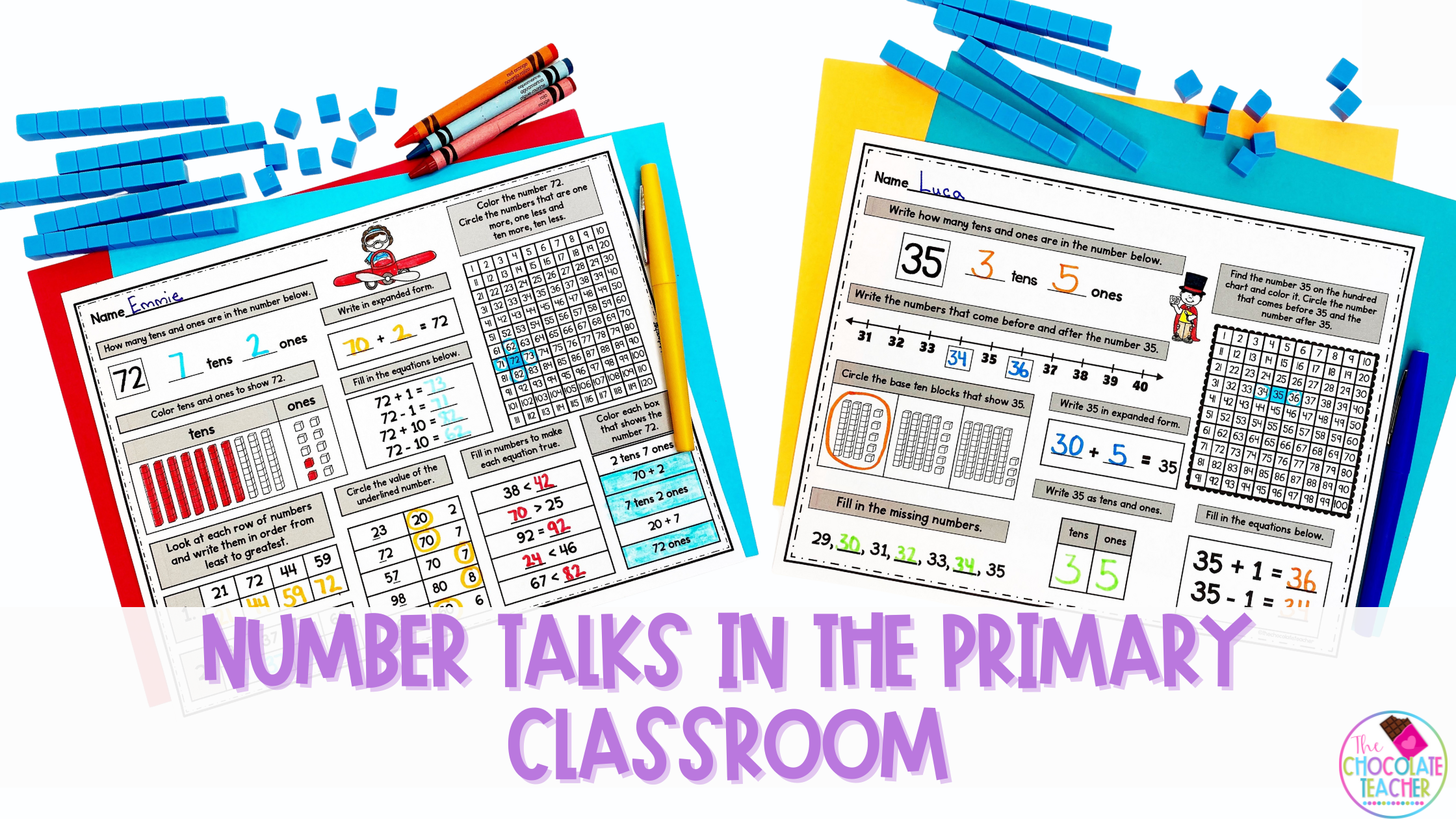What Are Number Talks?
Number talks are about to be your new next best friend! They require no special materials, no extra prep work, and will help your students grow tremendously in math skills. But what exactly are they? So glad you asked!
Number talks are short (10-15 minute) interactive exercises that allow for peer interaction/discussion to solve a problem. It's somewhat of a lesson, but instead of you doing all the modeling, you'll look to your students to help answer a problem and then talk everyone through how they got there.
The goal for most number talks in the primary classroom is to expand number sense skills and help children visualize the problem they're trying to solve. They offer the opportunity for students to share their answers, how they got them, and compare strategies used with peers. One of my favorite things about number talks is that they encourage students to verbally explain their thinking. Talking things out helps them learn to solve math problems in their heads.
These exercises also teach them that there are often many ways to find the answer to a math problem. As students share their answers and solutions, they will learn what others are doing to arrive at the same answer. This is such a great way to equip our kiddos for success and strengthen those mental math skills!
When To Have Number Talks With Students
So, now that you know what they are, when should we facilitate these conversations? My favorite time of the day to have number talks is right before we dive into our Daily Number Sense Practice Pages. This will "fire up" those little minds and get kiddos excited to put what we're learning into practice. Additionally, since we do these activities daily, that also means that my students will get an opportunity to work on mental math skills every day of the week!
You might also consider having these talks before you break off the day into small groups. This is another great time to sneak in a little math work and "warm up" for the day. But honestly, any time of day is a great time to squeeze a mental math challenge in, so make this fit where you can in your day!
What Types of Questions to Ask
Ahhh, so what should your number talks be about? This will vary slightly depending on what grade you're working with, but for the most part, they're going to revolve around number sense activities. These topics can be tough for kiddos to visualize, so they're a great candidate for your daily number talks.
For example, in our daily number sense activities, students focus on a specific number each day. There are a variety of activities that go along with each number to help students better understand place value using tens and ones. If you want to use "Number of the Day" as your jumping-off point for your number talks, this is a great place to start! Write your number up on the board and then present the students will a challenge to answer about the number.
Some skills you could feature for each number include breaking the number down into tens and ones, showing the number in expanded form, asking what numbers come before or after the number, or subtracting one and/or adding one to the number.
These are the types of questions you're likely working on in your math teaching groups using base ten blocks, Unifix cubes, or counting mats. Now don't get me wrong, I LOVE math manipulatives and we use them every day! However, it's also important to challenge those little minds to dig deep and use those abstract thinking skills to solve these problems in their heads as well.
Structuring Your Number Talks
The big question is how do we make these number talks successful? After all, if students are used to using manipulatives, how will they solve these problems? With some simple structure tips in mind, you can easily help students make the leap from hands-on learning to mental math magicians!
Model Problem Solving To Students
This first tip is more than likely something you already do in your weekly teaching. As I work through activities in our Daily Number Sense worksheets, I model how to solve specific problems. We use counting mats, number lines, and ten frames to solve. As I do this, I explain how I'm using these tools and model it over and over. You can even take this a step further by asking students to close their eyes and imagine "filling a tens frame" or "hopping on a number line". By simply sharing these tactics with students, you're preparing them with strategies to solve mentally in the future.
During your number talks, you can also model the strategies that students are explaining to you by using tools on the board or on the table. Magnetic base ten blocks or magnetic tens frames will come in really handy for this! As students provide their reasoning and strategy, use the tools to model it for everyone to see. You can even have students come up to the board and model it themselves if you like.
Provide Sentence Starters
Depending on your group of kiddos, there might be a need for a bit of prompting to get started with number talks. Some students will be eager and ready to share, while others might not be sure how to articulate their strategy for problem-solving. You can encourage the conversation by giving students a starting point to help them answer such as "My first step was...." or "I remembered we used ten frames to...". These types of prompts will help students put their strategy into words and share their answers with the class.
Use Hand Signals
If you've ever been in a classroom full of primary learners, you already know they're an excited bunch! Once your students understand number talks and learn how to express their strategies aloud, you might find that rather than crickets, you start hearing a whole lot of shouting out the answer.
Avoid this with the use of hand signals. Have students give a "thumbs up" sign if they think they know the answer. Ask them to hold it close to their body to avoid other kiddos looking around for hands in the air. This helps take some of the pressure off among your students, plus it will help you gauge how long students need to solve the problem.
Using Daily Number Sense Pages to Guide Math Talks
As I mentioned above, my favorite way to ensure that my students get daily opportunities to chat through math problems and share strategies with peers is alongside my Daily Number Sense Pages. These worksheets are designed to help your students master place value by using a spiral review of important skills. They'll work on counting, tens and ones, writing in expanded form, using a number line, skip counting, greater than or less than, and so much more!
Since these pages touch on all of the important things we're learning in math, I use them as the base for our daily number talks. I like to pull questions and challenges from the pages that students recently worked on in the last week or so. When everyone is seated at their desks or on the carpet, I write the problem or focus number on the board. I present the challenge aloud, and then, the kiddos get to work using mental math skills to solve the problem. Once they have their answer, they give me the thumbs up and when most students are done, I call on someone to answer.
Not only do they provide their answer, but I also ask them to explain how they got it. Some students might talk about glancing up at the number line, while others may visualize a tens frame. It's a good idea to call on multiple students to share their answers and how they got them to facilitate some conversation around the many strategies they can use to answer these questions.
The most important part of these exercises is the talking, so make sure to ask questions, prompt students for more details, and give everyone a chance to speak throughout the week. If you use daily number talks with related worksheets, you'll be in great shape to help your students excel in mental math skills!
Incorporating Other Math Skills
As the year progresses, your number talks will progress with the skills and concepts your students are learning. You can easily weave in number sense skills and critical thinking to problems about addition, subtraction, fractions, and telling time.
I like to have one problem each day during our math talk time. This allows multiple students to share their thinking process and how they found the answer. And. . . to save time you can use a problem that students have done in the past or will be doing on their next practice activity.
Get Started with Daily Number Talks
Doesn't this sound like fun?! I know once you start using number talks in your classroom, you'll be amazed by the strategies and skills your students use to problem solve. Another fantastic benefit to keep in mind is that they'll also likely help build a sense of community in your classroom. As students share ideas and chat about the problem, you'll see those lightbulbs going off and encourage teamwork. This is something I can't ever get enough of!
Get started with number talks by grabbing my FREE Daily Number Sense Worksheets. These pages are filled with great topics and challenge questions you can use as a starting point for your number talks. Plus, there are plenty of hands-on learning materials to facilitate deeper learning and modeling in your lessons as well!
Save This Post
This post is packed with info on how to get started with number talks in the primary classroom. Pin it on Pinterest so you can come back to it when you're ready to try it in your room!



.png)
.png)
.png)
.png)
.png)






0 Comments